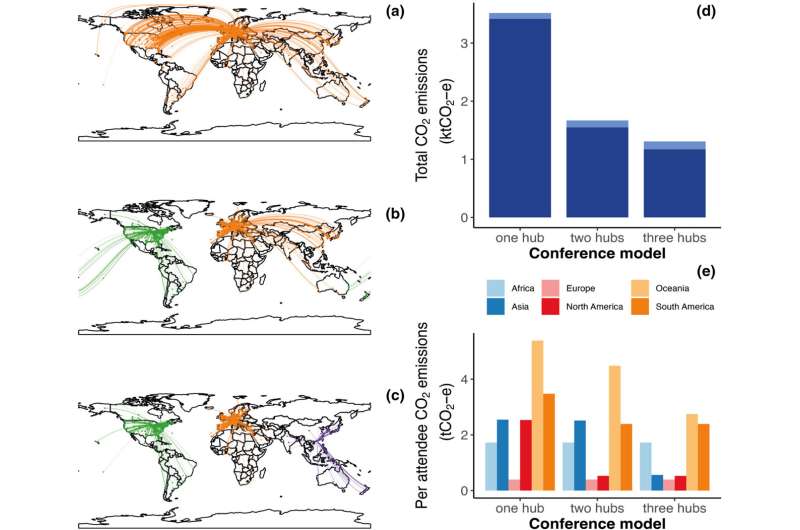This article has been reviewed according to Science X's editorial process and policies. Editors have highlighted the following attributes while ensuring the content's credibility:
fact-checked
peer-reviewed publication
trusted source
proofread
How scientific conference attendees can reduce their carbon footprint

Climate researchers often emphasize the fact that reducing carbon emissions is in everyone's best interest, and should involve all of us. But how good are they at minimizing their own carbon footprint?
A new study carried out jointly by Lund University in Sweden and the University of Lausanne in Switzerland shows that some of them use up half their annual carbon allowance in a single week. There are ways to cut these emissions, however, say the authors behind the study, now published in Limnology and Oceanography Letters.
Researchers have reviewed the emissions of delegates at an annual international water conference in the years from 2004 to 2023. The conference attracts an average of 1,500 attendees. In recent years, it has been held in places such as Puerto Rico, Hawaii and Majorca.
The average emissions per delegate for each conference were 1.3 metric tons of carbon dioxide. This figure can be compared to the level of annual emissions per person we need to align with to reach the goal of the Paris Agreement: 2.3 metric tons in 2030 and 1.4 metric tons by 2040.
"As a conference delegate, you are burning more than half of your annual CO2 budget in a week. The carbon dioxide that the delegates themselves generate when participating in conferences becomes the elephant in the room that no one really wants to talk about," says Emma Kritzberg, professor of biology at Lund University.
She says that carbon dioxide emissions from conferences requires more than superficial measures, such as vegetarian food—the research world should instead move to practical solutions to reduce the distances flown.
"Three years of virtual conferences have shown that they cannot fulfill the objectives of scientific meetings. The challenge here was to explore solutions that could maintaining some physical attendance while being carbon-efficient," says Marie Elodie Perga, Professor at the University of Lausanne and lead author of the paper.
"Academia taking serious steps to reduce its own emissions enhances credibility and could inspire other emissions-intensive organizations," argues Kritzberg.
"Among those who participate in these conferences, there is deep understanding of, and interest in, climate change and how it affects aquatic systems. In fact, 50% of all the presentations had to do with climate change. There was also a major focus on the need for this knowledge to be 'put into action' and 'bring about change,' not simply be communicated within the scientific field," says Kritzberg.
The Paris Agreement is the UN's climate agreement which came into force in 2016. It aims to limit the global rise in temperatures and to support those affected by the effects of climate change. The agreement states that the global rise in temperatures by the year 2100 is to be held well below two degrees and that we should limit the rise to 1.5° by reducing global emissions of greenhouse gases.
The new study points to several ways of significantly reducing carbon dioxide emissions resulting from scientific conferences. According to the research team, it is important that initiatives are targeted at the areas where they have the greatest impact. In practice, emphasizing the significance of only serving vegetarian food or using electric modes of transport locally does not carry much weight when set against the total emissions generated by the conference.
"Multihubbing leads to a third of the current carbon footprint of international conferences" says Marie-Elodie Perga. "Arranging parallel conferences in several locations at once, particularly in North America, central Europe and Asia, could reduce emissions considerably since most delegates would have a shorter journey. Not holding conferences on islands such as Majorca, Hawaii and Puerto Rico would also help," concludes Kritzberg.
More information: Marie‐Elodie Perga et al, The elephant in the conference room: reducing the carbon footprint of aquatic science meetings, Limnology and Oceanography Letters (2024). DOI: 10.1002/lol2.10402
Journal information: Limnology and Oceanography Letters
Provided by Lund University




















